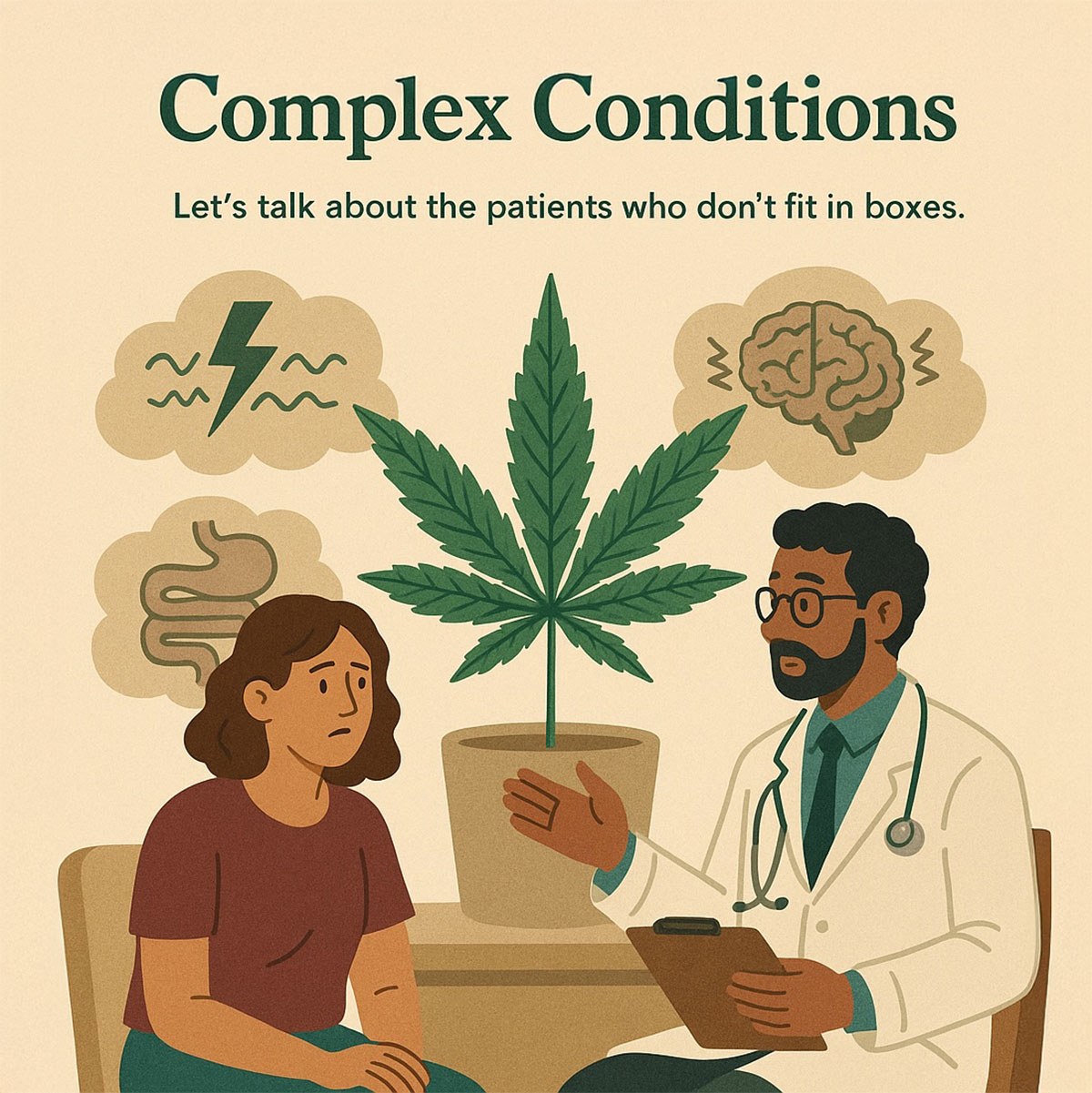Author: Dr. Kim, Medical Doctor at Aurea Care (Pen name)
Let’s talk about the patients who don’t fit in boxes.
The ones who’ve seen ten specialists and still don’t have a diagnosis. The ones whose symptoms shift, blend, flare, and fade—seemingly at random. The ones who get labeled with terms like functional, psychosomatic, or just filed under medically unexplained.
Fibromyalgia. IBS. PTSD. Chronic fatigue. Migraine. Tension myalgia. You’ve seen them. Maybe you are one of them. And if so, you’ve probably collected a pharmacy: antidepressants, anticonvulsants, antihistamines, maybe a benzo, maybe a steroid—maybe just a shrug.
These complaints are real, lived, and maddeningly resistant to single-target drugs. But here’s what’s weird—in a good way:
Cannabis often helps.
Not perfectly. Not for everyone. But more reliably than chance or placebo would suggest.
So why does this messy, old plant sometimes outperform modern medicine in complex conditions?
One Disease, One Drug?
Modern medicine loves a clean target. One receptor. One pathway. One molecule to block, boost, or beta-down.
It works beautifully—when the disease plays along. When the problem is single-source and well-behaved.
But conditions like CFS, fibromyalgia, IBS, and PTSD don’t play by those rules. They’re not single-issue malfunctions. They’re tangled webs of dysfunction, where the body’s systems amplify and loop through each other in unpredictable ways.
Let’s take a closer look at what that looks like in real life.
Chronic fatigue syndrome (CFS) isn’t about being tired.
It’s not even about running low on fuel. It’s about your body reacting like effort is danger—every time you spend energy on anything: walking, thinking, digesting lunch. This is CFS in a nutshell:
- The immune system overreacts to everything from a virus to a slice of bread.
- Mitochondria, the tiny engines that generate energy inside cells, slow down and lose efficiency.
- Neuroinflammation clouds the brain.
- Sleep becomes fragmented and stops restoring.
- And if you dare to exercise, your body logs it as a threat, hits the alarm, and makes you pay for days. That crash is called post-exertional malaise.
In CFS, the body wants to heal, but the systems that should support recovery have become wired against healing.
Fibromyalgia is a disorder of pain processing.
In fibromyalgia, the nervous system turns up the volume on pain and forgets where the dial is to turn it back down.
- The central nervous system becomes sensitized. Signals that shouldn’t hurt, do. Signals that should hurt, hurt more. This amplification is called central sensitization, and it includes phenomena like allodynia (pain from non-painful stimuli) and hyperalgesia (exaggerated pain response).
- Brain imaging consistently shows increased activity in regions like the insula and anterior cingulate cortex—areas involved in pain perception—even when no injury is present. The alarm keeps ringing, even without a fire.
- Normally, descending pathways from the brainstem act as brakes on incoming pain signals. In fibromyalgia, this inhibitory system underperforms. Pain builds, but nothing reins it in.
- Deep sleep becomes fragmented, especially slow-wave (stage 3) sleep. This matters because slow-wave sleep is when the brain recalibrates pain thresholds and the body repairs tissue. Disrupt it, and pain perception goes haywire.
- Neurochemical balance is off. Serotonin and norepinephrine, which help modulate pain, are often low. Substance P, which amplifies it, is elevated. And the HPA axis—your stress thermostat—doesn’t know which season it’s in, leaving the body in a state of constant threat readiness.
The result: a sensitized central nervous system stuck in overdrive — like someone jammed the pain dial to max and snapped off the knob. Signals get amplified, filtered poorly, and broadcast too loudly. The system keeps screaming pain, even when there’s no threat. Fibromyalgia is real, rewired physiology. A condition that often resists conventional painkillers, because the issue isn’t in the tissue. It’s in the signal.
IBS shows up in the gut.
But it’s orchestrated from higher up—along the gut-brain axis. That’s the two-way highway of
nerves, hormones, and microbes that links what you eat to how you feel.
- Serotonin plays a central role. In some patients, high serotonin causes cramping and diarrhea. In others, low levels lead to constipation and sluggish motility. It also amplifies pain signals, so normal sensations start to feel uncomfortable or even painful.
- Vagal tone drops, weakening the brain’s ability to tell the gut to calm down.
- Stress hormones like cortisol increase gut permeability, triggering immune activation and low-grade inflammation. Cortisol also disrupts motility, pushing food through too fast or holding it up too long.
- And the microbiome—that microbial cast of characters we barely understand—interacts with all of it. Sometimes stabilizing, sometimes throwing fuel on the fire.
One bad signal from the brain makes the gut twitch. One spasm in the gut tells the brain to panic. And round they go. A hypersensitive feedback loop caught in overdrive.
PTSD is physiology rewritten by trauma.
The threat passes, but the systems don’t reset. Flashbacks. Nightmares. REM sleep in tatters.
- The limbic system stays primed for danger—the amygdala hypervigilant, the hippocampus
stuck on replay.
- The sympathetic nervous system stays clenched, keeping muscles tense, pupils wide, and breath shallow.
- Dreams turn hostile. Rest becomes battleground.
- The HPA axis misfires, dumping cortisol every time the past taps on the door.
Trauma becomes etched across your systems. Fear moves into the body and rearranges the furniture like it owns the place. And you’re left inside a body that won’t stand down—not because it’s broken, but because it still thinks you’re under attack.
CFS, fibromyalgia, IBS, and PTSD aren’t simple cause-and-effect conditions. They’re system-wide storms. Pain, memory, mood, sleep, immunity, and autonomic tone all crash into each other and echo.
Pain disrupts sleep. Sleep loss fuels inflammation. Inflammation sharpens pain. And the loop feeds itself.
Trying to fix that with a single narrow-acting drug is like trying to fix a symphony by tuning one violin. Maybe the pitch improves. Slightly. But if the timpani’s stumbling, the horns are early, and the conductor’s on a smoke break, the music still comes out wrong.
These conditions don’t need stronger medicine. They need smarter medicine. Something that speaks the language of multiple biological systems. Something that meets the body where it’s messy, and helps it find rhythm again.
Enter: The Endocannabinoid System
So why does cannabis help where other meds don’t?
Because it taps into the endocannabinoid system (ECS)—a built-in regulator that helps balance mood, pain, inflammation, stress, digestion, sleep, and immune function. In other words, it regulates the same systems that go haywire in conditions like CFS, fibromyalgia, IBS, and PTSD—the ones that don’t fit in neat boxes, and rarely respond to single-target meds.
The ECS is a homeostatic system. It doesn’t fix one thing. It fine-tunes everything. Like mission control adjusting life support across a damaged spacecraft, it keeps the body from drifting further off course.
THC activates CB1 receptors in the brain and nerves. CBD modulates serotonin, reduces inflammation, and helps regulate gut motility. It’s not a sledgehammer. It’s more like an internal software patch—subtle, system-wide, and sometimes exactly what’s needed.
And in complex conditions where everything is cross-wired and overreacting, that kind of multi-system nudge can go further than any single-target drug ever could.
Why “Messy” Patients Sometimes Do Better
Patients with complex conditions often live in a state of internal noise: cortisol stuck on, muscles clenched, guts in revolt, sleep shattered. The ECS, when supported, can tune it down. Less static. Same signal. But now you can live with it.
Take fibromyalgia. It’s been linked to a low endocannabinoid tone—a deficiency in the body’s own cannabis-like compounds. Boosting that tone with phytocannabinoids may explain why some patients suddenly sleep better, hurt less, and feel emotionally more stable—even when no other variable has changed.
Or PTSD. Traditional meds can flatten emotions or slow cognition. But some patients describe cannabis as “bringing the volume down” on intrusive thoughts without numbing everything else. That’s the ECS dampening amygdala reactivity and rebalancing stress pathways.
IBS? Same story. CB1 and CB2 receptors line the gut. THC and CBD reduce cramping, normalize motility, and decrease gut hypersensitivity—especially when anxiety is in the mix.
Not a Cure, but a System Reset
This isn’t to say cannabis fixes these conditions. It doesn’t erase trauma, rebuild mitochondria, or reset circadian rhythms. But it can interrupt the feedback loops. It can help people rest, digest, lower the volume on threat, and feel safe enough to heal.
And that’s more than most polypharmacy regimens can promise.
When a patient finally sleeps through the night, eats without fear, or takes a pain-free walk, it doesn’t matter that the disease isn’t “cured.” The system has found a livable rhythm. The body may not reach perfect equilibrium or hormonal nirvana, but it’s no longer at war with itself. And that’s a start.
The Right Tool for the Right System
Cannabis carries promise precisely because it’s messy. A dirty, multi-target modulator. And for complex, multi-system conditions, that might be exactly what we need.
Most meds suppress symptoms. Cannabis supports the body’s own systems. It gives the body enough slack in the rope to start climbing out of the pit. Complex illness can feel like diagnostic failure. It shouldn’t. Complexity is a therapeutic clue. And cannabis, when used wisely, is one of the few tools built to meet that complexity on its own terms.

